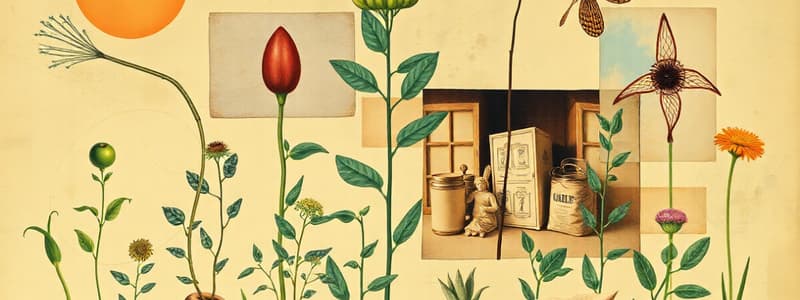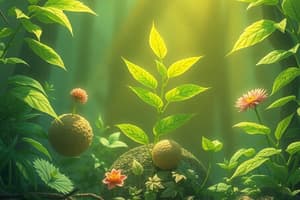Podcast
Questions and Answers
The components of food such as carbohydrates, proteins, and fats are called ______.
The components of food such as carbohydrates, proteins, and fats are called ______.
nutrients
Organisms that can make food themselves from simple substances have ______ nutrition.
Organisms that can make food themselves from simple substances have ______ nutrition.
autotrophic
Animals and most other organisms that take in food prepared by plants are called ______.
Animals and most other organisms that take in food prepared by plants are called ______.
heterotrophs
The mode of taking food by an organism and its utilization by the body is called ______.
The mode of taking food by an organism and its utilization by the body is called ______.
The cell is enclosed by a thin outer boundary called the cell ______.
The cell is enclosed by a thin outer boundary called the cell ______.
Most cells have a distinct, centrally located spherical structure called the ______.
Most cells have a distinct, centrally located spherical structure called the ______.
The nucleus is surrounded by a jelly-like substance called ______.
The nucleus is surrounded by a jelly-like substance called ______.
The pores on the surface of leaves that facilitate gas exchange are called ______.
The pores on the surface of leaves that facilitate gas exchange are called ______.
The green pigment found in leaves that helps capture the energy of sunlight is called ______.
The green pigment found in leaves that helps capture the energy of sunlight is called ______.
The process by which plants synthesize food using sunlight, carbon dioxide, and water is called ______.
The process by which plants synthesize food using sunlight, carbon dioxide, and water is called ______.
Since the synthesis of food occurs in the presence of sunlight, it is called ______.
Since the synthesis of food occurs in the presence of sunlight, it is called ______.
The ultimate source of energy for all living organisms is the ______.
The ultimate source of energy for all living organisms is the ______.
Plants synthesize carbohydrates through the process of photosynthesis using carbon dioxide, water, and ______.
Plants synthesize carbohydrates through the process of photosynthesis using carbon dioxide, water, and ______.
Plants cannot absorb nitrogen in gaseous form; they require it in a ______ form.
Plants cannot absorb nitrogen in gaseous form; they require it in a ______ form.
The bacterium that converts atmospheric nitrogen into a usable form for plants is called ______.
The bacterium that converts atmospheric nitrogen into a usable form for plants is called ______.
Plants that derive nutrition from dead and decaying matter are called ______.
Plants that derive nutrition from dead and decaying matter are called ______.
The mode of nutrition in which organisms take in nutrients from dead and decaying matter is called ______ nutrition.
The mode of nutrition in which organisms take in nutrients from dead and decaying matter is called ______ nutrition.
Organisms that live together and share both shelter and nutrients exhibit ______.
Organisms that live together and share both shelter and nutrients exhibit ______.
In lichens, a chlorophyll-containing partner and a fungus live together showing ______.
In lichens, a chlorophyll-containing partner and a fungus live together showing ______.
Insect-eating plants are called ______ plants.
Insect-eating plants are called ______ plants.
Flashcards
What are Nutrients?
What are Nutrients?
Components of food, like carbohydrates, proteins, fats, vitamins, and minerals, essential for the body.
What is Nutrition?
What is Nutrition?
The process by which organisms take in and utilize food.
What is Autotrophic Nutrition?
What is Autotrophic Nutrition?
Mode of nutrition where organisms make their own food from simple substances.
What are Autotrophs?
What are Autotrophs?
Signup and view all the flashcards
What are Heterotrophs?
What are Heterotrophs?
Signup and view all the flashcards
What are Cells?
What are Cells?
Signup and view all the flashcards
What is the Cell Membrane?
What is the Cell Membrane?
Signup and view all the flashcards
What is the Nucleus?
What is the Nucleus?
Signup and view all the flashcards
What is Cytoplasm?
What is Cytoplasm?
Signup and view all the flashcards
What are Stomata?
What are Stomata?
Signup and view all the flashcards
What is Chlorophyll?
What is Chlorophyll?
Signup and view all the flashcards
What is Photosynthesis?
What is Photosynthesis?
Signup and view all the flashcards
What role the Sun has in Photosynthesis?
What role the Sun has in Photosynthesis?
Signup and view all the flashcards
What are Saprotrophs?
What are Saprotrophs?
Signup and view all the flashcards
What is Saprotrophic Nutrition?
What is Saprotrophic Nutrition?
Signup and view all the flashcards
What is the definition of a parasite?
What is the definition of a parasite?
Signup and view all the flashcards
What is Symbiosis?
What is Symbiosis?
Signup and view all the flashcards
What is Rhizobium?
What is Rhizobium?
Signup and view all the flashcards
What are Insectivorous Plants?
What are Insectivorous Plants?
Signup and view all the flashcards
What are Lichens?
What are Lichens?
Signup and view all the flashcards
Study Notes
- Food is essential for all living organisms and its components which are carbohydrates, proteins, fats, vitamins and minerals, are called nutrients
- Nutrients are necessary for the body.
- All organisms require food.
- Plants can synthesise food for themselves however animals (including humans) cannot.
- Humans and animals depend directly or indirectly on plants.
Mode of Nutrition
- Plants can prepare their own food using water, carbon dioxide and minerals.
- Nutrients enables living organisms to build their bodies, grow, repair damages, and provide the energy that carries out life processes.
- Nutrition involves an organism taking food, and its utilisation within the body.
- Autotrophic nutrition is a mode by which organisms make food themselves from simple substances.
- Plants are autotrophs.
- Heterotrophs (animals and some other organisms), take food prepared by plants.
Photosynthesis
- Leaves are the food factories of plants, so all raw materials must reach the leaf.
- Water and minerals are absorbed through the roots and transported to the leaves.
- Carbon dioxide from the air is taken through tiny pores on the surface of leaves, and these pores are surrounded by guard cells called stomata.
- Water and minerals are transported to the leaves through vessels acting like pipes in the root, stem, branches, which create a continuous pathway for nutrients to reach the leaf.
- Leaves contain a green pigment called chlorophyll that captures sunlight energy.
- This energy is used to synthesise food from carbon dioxide and water.
- Photosynthesis : synthesis of food occurs with sunlight present.
- Chlorophyll, sunlight, carbon dioxide and water are necessary to carry out the process of photosynthesis.
- The sun is the ultimate source of energy for all living organisms.
- Without photosynthesis there would be no food and the survival of all living organisms, (directly or indirectly) would be affected.
- Oxygen is essential for survival
Other Facts
- Photosynthesis can also happen in other green parts of the plant, specially the green stems and green branches.
- Desert plants have scale/spine-like leaves to reduce water loss.
- Chlorophyll containing cells of leaves use carbon dioxide and water to synthesise carbohydrates with sunlight.
- The result of photosynthesis releases oxygen and the leaf stores starch which indicates it happened.
- Leaves besides green, can have red, brown and other pigments, but photosynthesis still takes place.
- Algae is green because of containing chlorophyll and can prepare their own food by photosynthesis.
- Carbohydrates consist of carbon, hydrogen and oxygen, and are used to synthesise proteins and fats.
- Proteins are nitrogenous substances containing nitrogen.
- Plants rely on bacteria to convert gaseous nitrogen into usable forms in the soil.
- They absorb nitrogen with water or from fertilizers.
Other Modes of Nutrition
- There are plants without Chlorophyll, so depend on food produced by other plants using heterotrophic nutrition.
- Cuscuta (Amarbel) ( that has no Chlorophyll), takes readymade food by climbing another plant.
- The plant Cuscuta climbs, is called the host, and it deprives the nutrients of the host, so Cuscuta is called a parasite.
- Insectivorous plants digest trapped insects to absorb nutrients.
- Fungi, Mushrooms etc utilize saprotrophic nutrition through which they obtain nutrients from dead, decaying matter, and these organisms are saprotrophs.
- Fungal pores in the air can land on wet and warm things when they germinate and grow.
- Symbiosis is when organisms live together sharing shelter and nutrients, for example, certain fungi live inside plant roots, plants provide nutrients to the fungus, and the fungus provides water/nutrients.
- Lichens are chlorophyll-containing organisms which have algae plus fungus living together, the fungus provides shelter, water and minerals to the alga, and the alga prepares/provides food for the fungus.
Replenishing Nutrients
- Plants absorb minerals and nutrients from the soil, so fertilisers and manures with nitrogen, potassium, phosphorous need to be added to enrich the soil and keep plants healthy.
- Rhizobium takes atmospheric nitrogen and convert it into a soluble form, living in the roots of gram, peas and beans.
- Plants provides the Rhizobium bacteria food/shelter exhibiting a symbiotic relationship, to reduce the use of nitrogenous fertiliser where leguminous plants are grown.
- Autotrophs: Plants that make their own food.
- Parasites or Saprotrophs: Few plants derive nutrition from other organisms.
- Heterotrophs: All animals depend on plants or other animals for food.
- Insectivorous plants are partial heterotrophs.
Studying That Suits You
Use AI to generate personalized quizzes and flashcards to suit your learning preferences.




